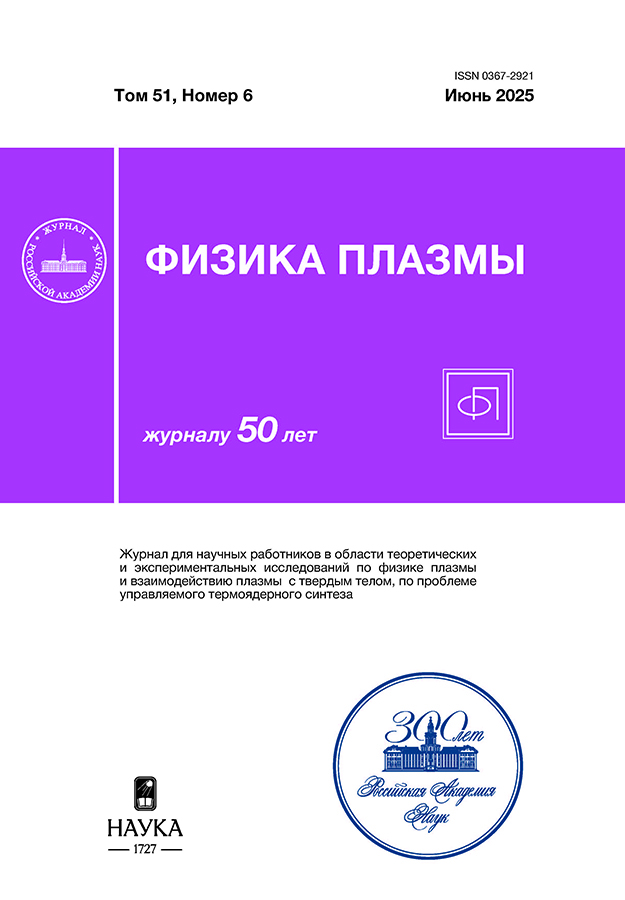Effect of the method of excitation of the plasma antenna on the spectral characteristics of the radiated signal
- Authors: Bogachev N.N.1, Bogdankevich I.L.1, Andreev S.E.1, Gusein-zade N.G.1, Usachenok M.S.2
-
Affiliations:
- Prokhorov General Physics Institute, Russian Academy of Sciences
- Stepanov Institute of Physics, National Academy of Sciences of Belarus
- Issue: Vol 50, No 3 (2024)
- Pages: 332-339
- Section: ION AND PLASMA SOURCES
- URL: https://ruspoj.com/0367-2921/article/view/668873
- DOI: https://doi.org/10.31857/S0367292124030073
- EDN: https://elibrary.ru/RFZGLI
- ID: 668873
Cite item
Abstract
The radiation of signal by the plasma asymmetrical vibrator antenna is studied for two methods of its excitation. Earlier, it was shown that the 2nd and 3rd harmonics of the input signal frequency in the radiation spectrum of the plasma antenna are 10—20 dB stronger than those of a metal antenna with the same geometry. In this work, we study experimentally and by computer simulations the effect of the method of excitation of the plasma asymmetrical vibrator antenna on the spectral characteristics of the signal that it radiates. For the two excitation methods of the antenna, through an electrode and through a coaxial coupler, it was shown that the strength of the signal components at the frequency of the radiated signal and its multiple harmonics is different. The introduction of the coaxial coupler in the antenna excitation scheme allowed us to improve the coupling at the input signal frequency and decrease its components at the 2nd and 3rd harmonics. For the plasma antenna with the coaxial coupler, the difference between the 1st and 2nd harmonics was increased by almost 6 dB, and between the 1st and the 3rd ones by almost 20 dB compared to the antenna excitation scheme through the electrode.
Full Text
About the authors
N. N. Bogachev
Prokhorov General Physics Institute, Russian Academy of Sciences
Author for correspondence.
Email: bgniknik@yandex.ru
Russian Federation, Moscow
I. L. Bogdankevich
Prokhorov General Physics Institute, Russian Academy of Sciences
Email: bgniknik@yandex.ru
Russian Federation, Moscow
S. E. Andreev
Prokhorov General Physics Institute, Russian Academy of Sciences
Email: bgniknik@yandex.ru
Russian Federation, Moscow
N. G. Gusein-zade
Prokhorov General Physics Institute, Russian Academy of Sciences
Email: bgniknik@yandex.ru
Russian Federation, Moscow
M. S. Usachenok
Stepanov Institute of Physics, National Academy of Sciences of Belarus
Email: bgniknik@yandex.ru
Belarus, Minsk
References
- Borg G. G., Harris J. H., Miljak D. G., Martin N. M. // Appl. Phys. Lett. 1999. V. 74. P. 3272. https://doi.org/10.1063/1.874041
- Rayner J. P., Whichello A. P., Cheetham A. D. // IEEE Trans. Plasma Sci. 2004. V. 32. P. 269. https://doi.org/10.1109/TPS.2004.826019
- Alexeff I., Anderson T., Parameswaran S., Pradeep E. P., Pulasani N. R., Karnam N. // IEEE Trans. Plasma Sci. 2006. V. 34. P. 166. https://doi.org/10.1109/TPS.2006.872180
- Liang C., Xu Y., Wang Z. // Chin. Phys. Lett. 2008. V. 25. P. 3712.
- Chen Z., Zhu A., LV J. // WSEAS Trans. Commun. 2013. V. 12. P. 63.
- Гусейн-заде Н.Г., Минаев И. М., Рухадзе А. А., Рухадзе К. З. // Кр. сообщ. по физике ФИАН. 2011. № 3. С. 42.
- Bogachev N. N., Bogdankevich I. L., Gusein-zade N.G., Sergeychev K. F. // Acta Polytechnica. 2015. V. 55. P. 30. https://doi.org/10.14311/AP.2015.55.0034
- Ковалев А. С., Вожаков В. А., Кленов Н. В., Аджемов С. С., Терешонок М. В. // Физика плазмы. 2018. Т. 44. С. 211. https://doi.org/10.7868/S0367292118020075
- Беляев Б. А., Лексиков А. А., Лексиков Ан.А., Сержантов А. М., Бальва Я. Ф. // Изв. вузов. Физика. 2013. Т. 56. С. 88.
- Bogachev N. N. // J. Phys.: Conf. Ser. 2015. V. 661. P. 012054. https://doi.org/012054.10.1088/1742-6596/661/1/012054
- Bogachev N. N., Gusein-zade N.G., Nefedov V. I. // Plasma Phys. Reports. 2019. V. 45. P. 372. https://doi.org/10.1134/S1063780X19030024
- Tarakanov V. P. User’s Manual for Code KARAT. Springfield, VA: Berkley Research Associates, Inc., 1992.
- Berenger J. P. // IEEE Transactions on Antennas and Propagation. 1996. V. 44. P. 110. https://doi.org/10.1109/8.477535
- Богачев Н. Н., Богданкевич И. Л., Гусейн-заде Н.Г., Рухадзе А. А. // Физика плазмы. 2015. Т. 41. C. 365. https://doi.org/10.7868/S0367292115100030
- Горбунов Л. М. Введение в электродинамику плазмы. М.: Изд-во Ун-та дружбы народов, 1990. 127 с.
Supplementary files

















